
Trikes mostly fall into one of two main design categories: delta and tadpole. How do they compare?
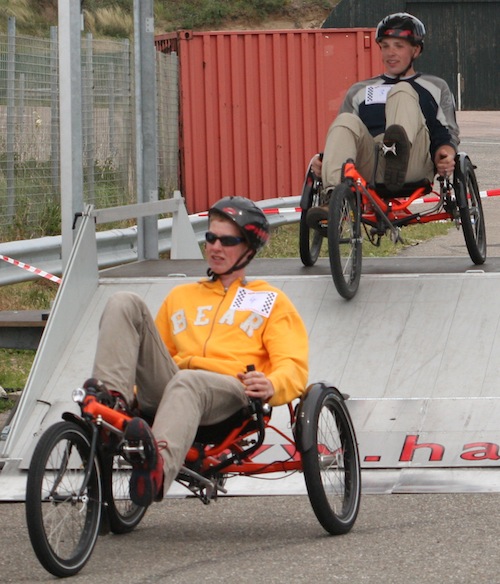
- Details
- Category: Cycling
The cmpct, which is a model first seen at the FietsRAI in 1998, is one of the very few folding recumbents available ready built. It was built for Bram Moens's M5 company, one of the pioneers of recumbents in the Netherlands, but it's a bit outside their usual line, and wasn't in production all that long, I think. Unusually for Holland, it is a compact long wheelbase (clwb) design, with the bracket directly over the 16″ front wheel. This makes it look rather long, but seems to give it much less “nervous” steering characteristics than you would expect from the small wheel and long handlebar stalk. After riding swb recumbents like the Wizard, you have to get used to the idea that the bike steers from the front not the middle. The ride is also a lot friskier than the Wizard - the frame is very light and flexible.
I went to the dealer for a test ride, and liked it at once - so much so that they immediately got their spanners out, put a carrier on, changed the gears (an 8 speed cassette with 11–28 should give me enough range for the occasional trip to Yorkshire or the Ardennes, I hope) and fitted spd pedals, and I was able to ride home on it a couple of hours later. Foolishly, I thought I would fit an odometer myself, only to discover that the handlebar stalk is some 20cm longer than the maximum range of the cordless models I tried (70cm). So it was a case of taking an old odometer from another bike and soldering in an extra length of coax cable. Seems to work so far…
I have used the cmpct occasionally for day tours combined with rail travel - I haven’t had any negative reactions from railway staff, unless you count the time when a train was delayed for five minutes because the driver and conductor were busy chatting with me about recumbents. However, it's not the most practical folding bike for everyday use. It is quite a bit bulkier than most, and the oily bits seem to be everywhere at once. It’s too awkward a package in folded state to carry any distance, but it does fold and unfold very quickly.
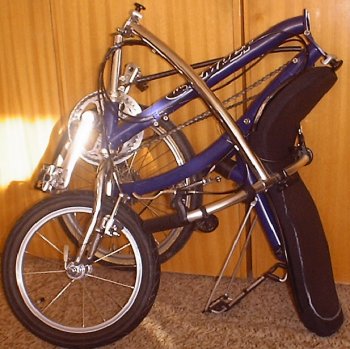
On tours I find that I am able to keep up a reasonable speed and arrive significantly less tired than I would be on the Brompton. I did have some minor problems with the chain - the nylon tube that is supposed to protect it was a bit too long (the ideal length depends on the wheelbase, which is adjustable to suit the length of your legs), and thus it got bent on folding the bike, and subsequently tended to catch in the chain, so that I had to remove it. Since I don’t wear “respectable” clothes for that sort of cycling, it is not very vital anyway.
Another luxury I do without is mudguards - inevitably, my second ride took me over a lot of sandy forest tracks in wet weather. It is amazing just how thoroughly you and the bike can get covered in sand in these conditions…

Extra notes:
(someone emailed me with a few detailed questions)
Folded size - resting on both wheels and the carrier - is h 830 x w 980 x d 350 mm max, as near as I can measure. With the back wheel in the air it’s a bit narrower, about 880 mm. Taking the front wheel off would make it smaller, and for long journeys I think it could probably be dismantled into a suitcase sized package. There’s nothing to hold it together when folded - I’m looking for a convenient strap.
According to Danny Siepman’s article, you can get a front derailleur or a hub gear as options. A cheap & dirty solution if you want extra gears would be to fit an extra chainring or two (the crankset has the mounting holes for them) and use the nylon tube as a front derailleur.
The brakes are Tektro sidepull cantilevers - a type I haven’t seen before, but they seem to work just as well as Maguras so far. However, I notice that the front rim is already scored a little, after 300km mainly in the dunes and over sandy forest tracks. Wonder if there’s anywhere non-sandy to ride around here?
The main frame tube is telescopic - in the folded picture you can see two quick-releases (mine just has bolts) just where the chain passes behind it. When you adjust the bike to your body size, the front wheel moves as well as the pedals. A potential problem with this arrangement is that the front end can twist around if you inadvertently apply a large sideways force for some reason (e.g. when falling off!).
The seat is laminated wood, and has a flat bit ca w 290 x l 250 mm, and a back 480 mm long at about 50 degrees to the horizontal (could be adjusted a little by altering the thickness of the suspension block, according to ds). Seems a bit wider than the standard M5, as far as I can remember from last time I rode one. The cushion is foam with a cloth cover. Fairly sweaty, but not excessively so.
20″ front & back aero wheels are available as an option. I think “aero wielen” must be deep, narrow racing rims, like the ones on the M5 20/20. The front fork is big enough for a 20″ wheel, though you’d have to weld on new brake lugs if you wanted to do a retrofit.
M5 City Mate is a non-folding version, [apparently identical apart from the hinges] distributed by Speedliner for nlg 1399
“Vering” is a rubber block rear suspension, with a bit more give in it than the Brompton. Very necessary on any recumbent, in my experience. Does resonate slightly on some brick-tiled roads, but that shouldn’t be a problem outside Belgium and Holland!.
- Details
- Category: Cycling
The Flevobike was originally developed by Johann Vrielink in 1986-1987 as a project for schools. The Vrielink family set up the Flevobike company to manufacture the Bike in 1989; the Trike version was introduced in 1991. It is a design which is eccentric even by recumbent standards. It uses an idiosyncratic "mid-steering" system (''kantel-kniksysteem''), in which the frame is in two parts joined by a hinge under the front edge of the seat. The hinge is controlled by a rubber damper (diabolo). You steer by leaning into the bend, moving your legs relative to the seat. An advantage of the system is that the modular system allows you to use the same front frame with either a bike or trike rear frame.
I bought my Trike secondhand from someone in Amsterdam, via an advertisement in ''HPV Nieuws''. After a few lessons in the street outside his apartment, I was confident enough to ride it the 60 km or so back to The Hague. Fortunately, nothing major went wrong on the way, but it was a bit nerve-wracking at first. I did feel very stiff the next day, but found after a bit of trial and error that it was a lot easier to get going with the bars mounted on the rear frame rather than under the seat.
- Details
- Category: Cycling
The youngest member of my stable of trikes is the '''Mad Max''', a fully-suspended tadpole trike designed in Austria with a frame built in Serbia. It's a bit less extreme than the Trice Micro -- higher seat, more baggage capacity, springs that let me ride over bad paving without being shaken to death. A very comfortable all-purpose trike, and to contrast with the Micro I chose a suitably lurid colour scheme.
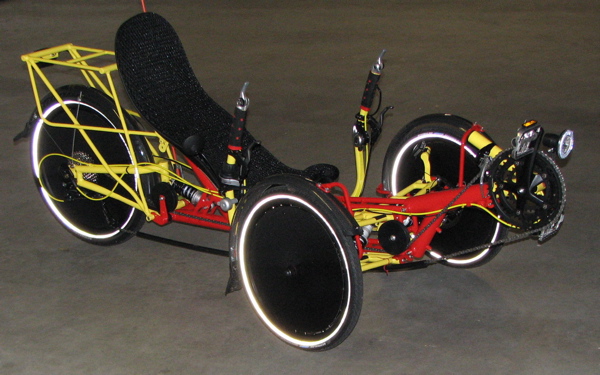
.
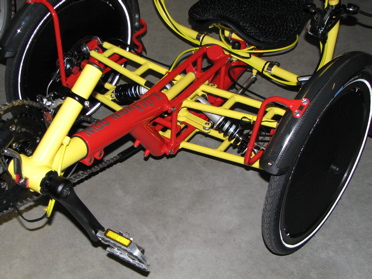
- Details
- Category: Cycling
The Trice Micro, which I’ve had since 2003, was my first “tadpole” trike (two wheels at the front). Made by I.C.E. in Cornwall, beautifully designed and constructed, low, light, nippy, and enormous fun to ride. At the time, it was just about the smallest trike you could get, which suited me because I only had a rather small and inaccessible basement to keep it in. If I were in the same situation nowadays, I’d probably be looking at something like a Greenspeed gt3, which is considerably cheaper and has the added advantage of being foldable.
The Micro has three 16″ wheels and was originally designed as an uncompromising light, fast tourer for brevet riders (that’s why I.C.E. supplied it with six bottle cages, I suppose).
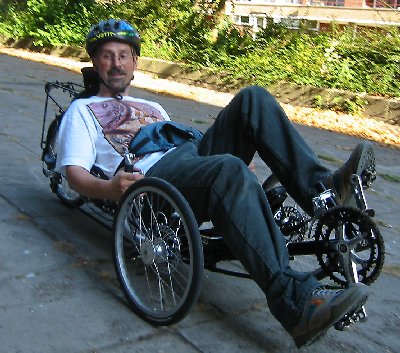
I ordered my Micro direct from I.C.E., who were very helpful in answering all my silly questions. It took some time to get to the front of the production queue, but it was ready on precisely the day they promised, and six days later it arrived here, dismantled and packed in two big boxes.
It took me most of the afternoon to get from this:
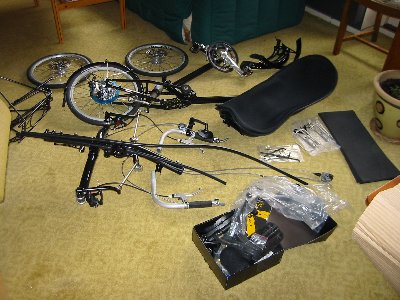
to this:
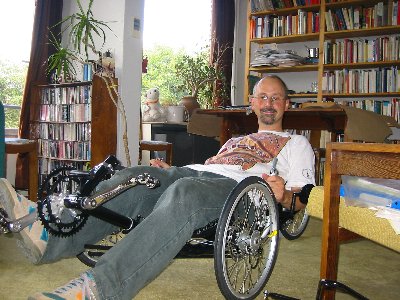
A friend turned up at the critical moment to hold bits of of chain together, and between us we soon had the last few bits bolted on, and were able to take it for a gentle spin around the block. Slightly nerve-wracking at first (will it go round this corner..? — yes!), but by the time we got back I was definitely smiling.
A few minor adjustments, then I took it for a 30km “shakedown” ride (“shake” being the operative word on some of the roads around here). I would have gone further, but I hadn’t put any lights on it yet. A few bits had to be tightened up or adjusted en route, but everything seems to be working, and it’s huge fun to ride.
Interesting, too, to see the reactions of passers-by — no-one here looks twice at a recumbent these days, but on the Micro I’m getting the sort of looks and comments (all good-humoured so far) I was getting when I first started riding recumbents seven years ago. Trikes (other than upright deltas) are very thin on the ground in Holland — even Quests and Mangos are not exactly an everyday sight, although there are a couple of people around here with Sinner recumbent deltas.
A lot of people ask me if a trike isn’t too wide for narrow Dutch cycle paths. The canal towpath between Vlaardingen and Schipluiden is one of the narrowest around here, and the Micro just about fits (its overall width is about 70cm). There were one or two spots where I was riding - very slowly - with one wheel in the grass. [nb: This was at eight on a Sunday morning — I don’t think I would have been very popular riding this stretch in the afternoon when it gets busy…]
With its low ground clearance, the Micro isn’t intended for off-road riding, but it doesn’t seem to have any difficulties with a reasonably smooth path like this one. Notice that the weather has got back to normal, and I’ve fitted the mudguards which are not in the other photos above. You can also see the ice flag (if anyone asks, it’s the antenna for the on-board navigation system…), cheap and cheerful led rear lamp, and a Karrimor front pannier that must be at least twenty years old.

- Details
- Category: Cycling
Subcategories
Page 1 of 3
